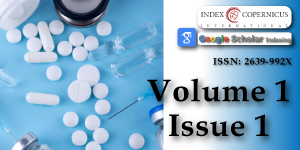Paediatric Medicines: Formulation Considerations
Main Article Content
Abstract
The use of unlicensed and off-label medicines in children is widespread and has raised an increasing concern over the last years. The majority of medicines taken by children are extemporaneously compounded by pharmacist, and there is a lack of information regarding bioavailability, suitability and stability. These formulations must be prepared from pure active substance and not from commercially available dosage forms. The development of paediatric formulations, particularly those suitable for very young children, can be a challenge to pharmacists. There is limited knowledge available about the acceptability of different dosage forms, administration volume, dosage form size, taste, safety of formulation excipients regarding to age and development status. The selection of formulation and route of administration depends on the disease being treated and the clinical condition. European Guidelines and reflection papers recommend that pharmaceutical development should consider some parameters like capability, acute or long-term illness, caregiver convenience, disability, culture differences and formulations more attractive to children must be explored.
Article Details
Copyright (c) 2017 Roque F.

This work is licensed under a Creative Commons Attribution 4.0 International License.
European Comission. Better Medicines for children. Proposed regulatory actions on paediatric medicinal products. 2002.
European Parliament and Council of European Union. Regulation (EC) No. 1901/2006 of the European Parliament and of the Council of 12 December 2006 on Medicinal Products for Paediatric Use. Official Journal of the European Union. 2006.
European Medicines Agency and Paediatric Committee. 10-year Report to the European Commission General report on the experience acquired as a result of the application of the Paediatric Regulation”. 2016.
Corny J, Lebel D, Bailey B, Bussieres JF. Unlicensed and Off-Label Drug Use in Children Before and After Pediatric Governmental Initiatives. J Pediatr Pharmacol Ther. 2015; 20: 316-328. Ref.: https://goo.gl/U6Rfrt
Magalhaes J, Rodrigues AT, Roque F, Figueiras A, Falcao A, et al. Use of off-label and unlicenced drugs in hospitalised paediatric patients: a systematic review. Eur J Clin Pharmacol. 2015; 71: 1-13. Ref.: https://goo.gl/h9SJ3G
Sohn M, Moga DC, Blumenschein K, Talbert J. National trends in off-label use of atypical antipsychotics in children and adolescents in the United States. Medicine (Baltimore). 2016; 95: e3784. Ref.: https://goo.gl/JKpDE6
Sonninen K, Jyrkka J, Martikainen JE, Malmstrom K, Makela MJ, et al. Age-related off-label use of nasal corticosteroids for allergies is relatively common in Finnish children with asthma. Acta Paediatr. 2017. Ref.: https://goo.gl/pVRHDS
Lai LL, Koh L, Ho JA, Ting A, Obi A. Off-Label Prescribing for Children with Migraines in U.S. Ambulatory Care Settings. J Manag Care Spec Pharm. 2017; 23: 382-338. Ref.: https://goo.gl/JCkAtt
Schröder C, Dörks M, Kollhorst B, Blenk T, Dittmann RW, et al. Outpatient antidepressant drug use in children and adolescents in Germany between 2004 and 2011. Pharmacoepidemiol Drug Saf. 2017; 26: 170-179. Ref.: https://goo.gl/GkvNFD
Schröder C, Dörks M, Kollhorst B, Blenk T, Dittmann RW, et al. Outpatient antipsychotic drug use in children and adolescents in Germany between 2004 and 2011. Eur Child Adolesc Psychiatry. 2017; 26: 413-420. Ref.: https://goo.gl/bRHxfC
Nahata MC, Allen LV. Extemporaneous drug formulations. Clin Ther. 2008; 30: 2112-2119. Ref.: https://goo.gl/rfYfoq
Fabiano V, Mameli C, Zuccotti GV. Paediatric pharmacology: remember the excipients. Pharmacol Res. 2011; 63: 362-365. Ref.: https://goo.gl/JGUhbK
Nogueira F, Carvalho A, Tavares L, Ribeiro MP, Coutinho P, et al. Generic Drugs and Brand Name Products: an approach about excipients. Rev Saúde Pública. 2014; 48: 102. Ref.: https://goo.gl/uz2hKt
European Comission, Guideline Excipients in the label and package leaflet of medicinal products for human use. 2003.
Roque F, Rama AC, Sousa JJ, Pina ME. Development and stability assessment of liquid paediatric formulations containing sildenafil citrate. Brazilian J Pharm Sci. 2013; 49: 381-388. Ref.: https://goo.gl/m7DdGM
Provenza N, Calpena AC, Mallandrich M, Halbaut L, Clares B. Design and physicochemical stability studies of paediatric oral formulations of sildenafil. Int J Pharm. 2014; 460: 234-239. Ref.: https://goo.gl/9kbyHg
Alemón-Medina R, Chávez-Pacheco JL, Rivera-Espinosa L, Ramírez-Mendiola B, García-Álvarez R, et al. Extemporaneous Formulations of Metformin for Pediatric Endocrinology: Physicochemical Integrity, Cytotoxicity of Sweeteners, and Quantitation of Plasma Levels. Clin Ther. 2015;37: 1689-1702. Ref.: https://goo.gl/xvTvCe
de Goede AL, Boedhram RR, Eckhardt M, Hanff LM, Koch BC, et al. Development and validation of a paediatric oral formulation of clonidine hydrochloride. Int J Pharm.2012; 433: 119-120. Ref.: https://goo.gl/pAvWUZ
Juarez Olguin H, Flores Perez C, Ramirez Mendiola B, Coria Jimenez R, Sandoval Ramirez E, et al. Extemporaneous suspension of propafenone: attending lack of pediatric formulations in Mexico. Pediatr Cardiol. 2008;29: 1077-1081. Ref.: https://goo.gl/6ee3YD
Sunkara G, Bende G, Mendonza AE, Solar-Yohay S, Biswal S, et al. Bioavailability of valsartan oral dosage forms. Clin Pharmacol Drug Dev. 2014; 3: 132-138. Ref.: https://goo.gl/96tiJF
Batchelor HK, Marriott JF. Formulations for children: problems and solutions. Br J Clin Pharmacol. 2015; 79: 405-418. Ref.: https://goo.gl/Vy9trj
Liu F, Ranmal S, Batchelor HK, Orlu-Gul M, Ernest TB, et al. Formulation factors affecting acceptability of oral medicines in children. Int J Pharm. 2015; 492: 341-343. Ref.: https://goo.gl/SsDux5
European Medicines Agencie. Committee for Medicinal Products for Human Use (CHMP) Paediatric Committee (PDCO). Guideline on pharmaceutical development of medicines for paediatric use. 2013.
Zajicek A, Fossler MJ, Barrett JS, Worthington JH, Ternik R, et al. A report from the pediatric formulations task force: perspectives on the state of child-friendly oral dosage forms. AAPS J. 2013; 15: 1072-1081. Ref.: https://goo.gl/Zma5Wg
Ivanovska V, Rademaker CM, van Dijk L, Mantel-Teeuwisse AK. Pediatric drug formulations: a review of challenges and progress. Pediatrics. 2014; 134: 361-372. Ref.: https://goo.gl/rAQsz2
Elder DP, Kuentz M, Holm R. Pharmaceutical excipients - quality, regulatory and biopharmaceutical considerations. Eur J Pharm Sci. 2016; 87: 88-99. Ref.: https://goo.gl/JPfwH9
Ranmal SR, Cram A, Tuleu C. Age-appropriate and acceptable paediatric dosage forms: Insights into end-user perceptions, preferences and practices from the Children’s Acceptability of Oral Formulations (CALF) Study. Int J Pharm. 2016; 514: 296-307. Ref.: https://goo.gl/Ge3AwK
Mennella JA, Roberts KM, Mathew PS, Reed DR. Children’s perceptions about medicines: individual differences and taste. BMC Pediatr. 2015; 15. Ref.: https://goo.gl/Pdn4fz





